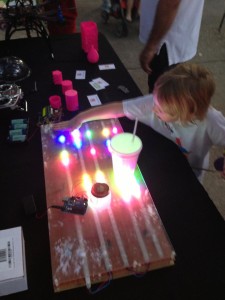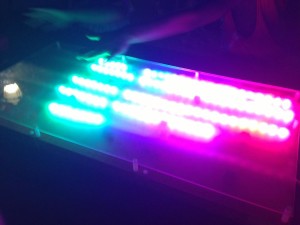I spent time working with folks from Mobile Makers this summer. We have been steadily building interest and membership by participating in LoDA ArtWalks and JagFest. August we held our first workshop at Ashland Gallery. A goal of the group is to establish a permanent space for members to share tools, work on projects, and hold workshops.
The July ArtWalk we presented some embedded devices, Patrick’s quadcopter, made LED throwies, and had hands-on with drawdios.
August ArtWalk I built an interactive LED table for a hands-on activity. The LED table has IR proximity sensors embedded in different locations under a lexan cover. When a sensor is activicated the LEDs in the area light up and cycle through colors. The main components of the table are the sensors, LED light strip, power supply, and Arduino mega.
The light strip is from Adafruit. It has 60 RGB LEDs per meter with each LED addressable for controlling its color. The strip was cut and arranged in 5 rows. I have purchased 4 meters, but I think I fried a meter of lights. The light strip is still a single linear strip. The end of the first row connects to the end of the second row, the beginning of the second row connects to the beginning of the third row. The end of the third row connects to the end of the forth row. When talks to the strip the addressable LEDs are treated as an index in to a single array. In the manipulation of the lights I want to deal with Cartesian coordinates. This simplifies programming so I can treat the light array as a matrix and not worry about the physical offset of the actual LED.
The proximity sensors form a matrix. Each of the sensors has a data line along with power and ground. Compare this to the LED strip where the entire strip is a single data, power, and ground. The proximity matrix is made up of 13 sensors set up in rows and offset columns. The spacing is wonky because I limited myself to $100 on sensors and didn’t have enough to increase the density.
The sensor matrix is held on a series of protoboards. I have 9 protoboards arranged to make a 1ft by 2ft plane. The protoboards are held off the surface by nylon spacers. There is a Lexan surface held on top of the matrix by more nylon spacers. The table has a barrel power connector that is used to connect either a battery pack or a power transformer. The table connects to the Arduino mega to supply power, data signal for the lights, and data lines for each of the sensors. It makes quite a mess that could probably be cleaned up with a ribbon cable. Also attached to the Arduino mega is a custom controller interface with LCD and 2 buttons. The interface lets to user select from a set of predefined color pallets.
For demonstration at the August ArtWalk I used a 4xD cell battery pack. It was able to power the table and controller for 2-3 hours. Near the end of the evening I think the response time seemed different compared to freshly charged batteries. Purely subjective observation.